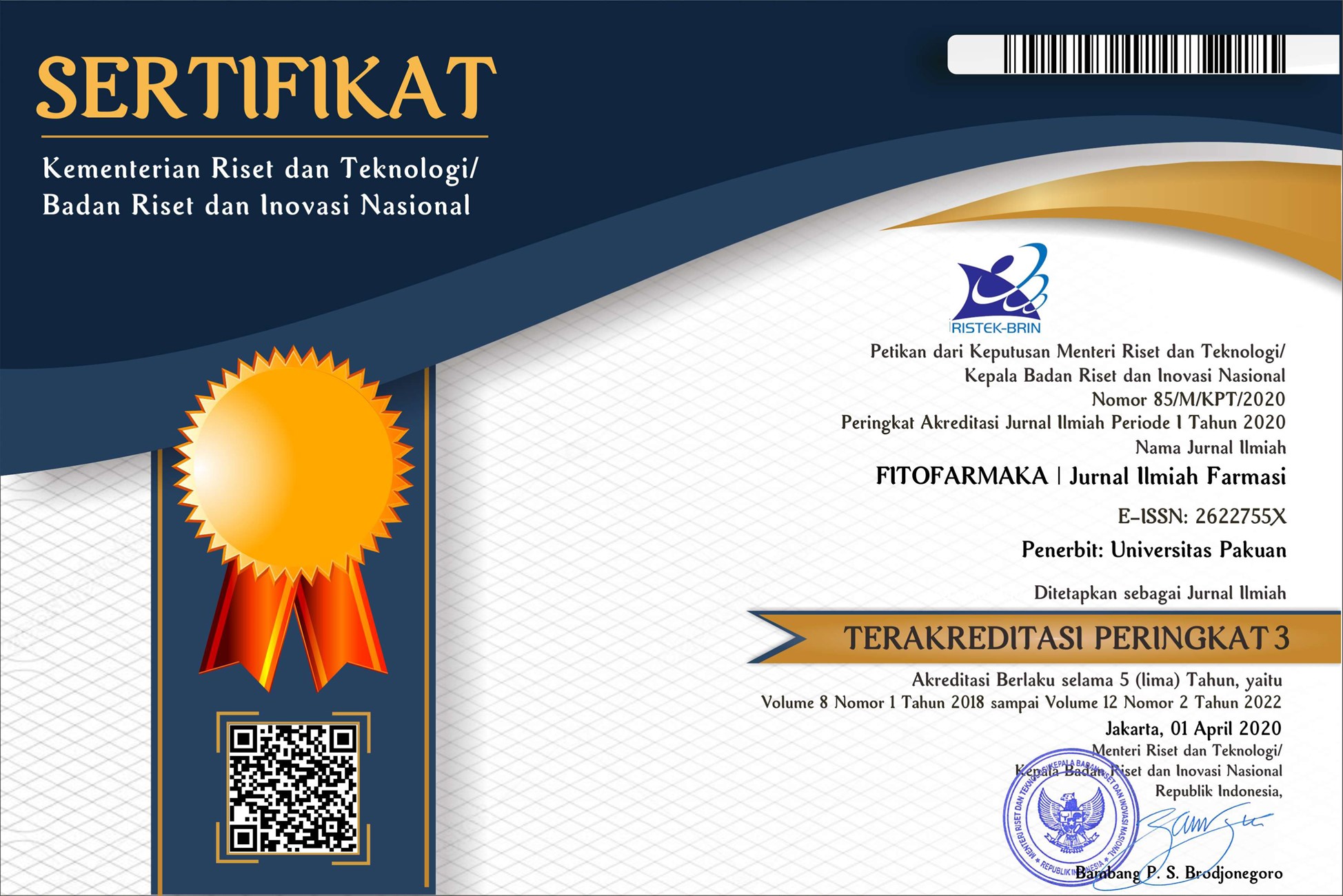Dexamethasone and 5% NaCl Solution Induce Hypertension in Sparangue dawly Male Rats
Abstract
Keywords
References
Adeosun, A. M., Aroworamimo, A. D., Ighodaro, O. M., Asejeje, F. O., & Akinloye, O. A. (2021). Blood pressure lowering, antidyslipidemic and nitric oxide modulatory effects of methanol extract of struchium sparganophora leaves on dexamethasone-salt model of hypertension in rats. Egyptian Journal of Basic and Applied Sciences, 8(1), 252260. https://doi.org/10.1080/2314808X.2021.1961206
Bergler-Klein, J. (2019). Whats new in the ESC 2018 guidelines for arterial hypertension: The ten most important messages. Wiener Klinische Wochenschrift, 131(78), 180185. https://doi.org/10.1007/s00508-018-1435-8
Blecharz-Lang, K. G., & Burek, M. (2017). Role of Endothelial Nitric Oxide Synthase in Glucocorticoid- Induced Hypertension: An Overview of Experimental Data. Nitric Oxide Synthase - Simple Enzyme-Complex Roles. https://doi.org/10.5772/67025
Cameron, A. C., Lang, N. N., & Touyz, R. M. (2016). Drug Treatment of Hypertension: Focus on Vascular Health. Drugs, 76(16), 15291550. https://doi.org/10.1007/s40265-016-0642-8
El-Sonbaty, Y. A., Suddek, G. M., Megahed, N., & Gameil, N. M. (2019). Protocatechuic acid exhibits hepatoprotective, vasculoprotective, antioxidant and insulin-like effects in dexamethasone-induced insulin-resistant rats. Biochimie, 167, 119134. https://doi.org/10.1016/j.biochi.2019.09.011
Filippopoulou, F., Habeos, G. I., Rinotas, V., Sophocleous, A., Sykiotis, G. P., Douni, E., & Chartoumpekis, D. V. (2022). Dexamethasone administration in mice leads to less body weight gain over time, lower serum glucose, and higher insulin levels independently of nrf2. Antioxidants, 11(1). https://doi.org/10.3390/antiox11010004
Frühbeck, G., Catalán, V., RodrÃguez, A., RamÃrez, B., Becerril, S., Portincasa, P., & Gómez-Ambrosi, J. (2017). Normalization of adiponectin concentrations by leptin replacement in ob/ob mice is accompanied by reductions in systemic oxidative stress and inflammation. Scientific Reports, 7(1), 112. https://doi.org/10.1038/s41598-017-02848-0
Garmana, A. N., Sukandar, E. Y., & Fidrianny, I. (2018). Antihypertension study of anredera cordifolia (Ten). V. steenis extract and its fractions in rats through dexamethasone induction and nitric oxide release. In Asian Journal of Pharmaceutical and Clinical Research (Vol. 11, Issue 1, pp. 278282). https://doi.org/10.22159/ajpcr.2018.v11i1.22312
Giles, A. J., Hutchinson, M. K. N. D., Sonnemann, H. M., Jung, J., Fecci, P. E., Ratnam, N. M., Zhang, W., Song, H., Bailey, R., Davis, D., Reid, C. M., Park, D. M., & Gilbert, M. R. (2018). Dexamethasone-induced immunosuppression: Mechanisms and implications for immunotherapy. Journal for ImmunoTherapy of Cancer, 6(1), 113. https://doi.org/10.1186/s40425-018-0371-5
Harvey, A., Montezano, A. C., & Touyz, R. M. (2015). Vascular biology of ageing-Implications in hypertension. Journal of Molecular and Cellular Cardiology, 83, 112121. https://doi.org/10.1016/j.yjmcc.2015.04.011
Jouda, J. (2016). The effect of long-term oral dexamethasone on blood cells counts and brain regions of young mice. September.
Joukar, S., Ebrahimi, S., Khazaei, M., Bashiri, A., Shakibi, M. R., Naderi, V., Shahouzehi, B., & Alasvand, M. (2017). Co-administration of walnut (Juglans Regia) prevents systemic hypertension induced by long-term use of dexamethasone: A promising strategy for steroid consumers. Pharmaceutical Biology, 55(1), 184189. https://doi.org/10.1080/13880209.2016.1233570
Kamphuis, P. J. G. H., De Vries, W. B., Bakker, J. M., Kavelaars, A., Van Dijk, J. E., Schipper, M. E., Van Oosterhout, M. F. M., Croiset, G., Heijnen, C. J., Van Bel, F., & Wiegant, V. M. (2007). Reduced life expectancy in rats after neonatal dexamethasone treatment. Pediatric Research, 61(1), 7276. https://doi.org/10.1203/01.pdr.0000249980.95264.dd
Kapugi, M., & Cunningham, K. (2019). Corticosteroids. Orthopaedic Nursing, 38(5), 336339. https://doi.org/10.1097/NOR.0000000000000595
Kepala, B. (2021). Regulation of the Food and Drug Supervisory Agency Number 18 of 2021 concerning Guidelines for Preclinical Pharmacodynamic Testing of Traditional Medicines. Bpom Ri, 1, 1524.
Krajina, I., Stupin, A., Šola, M., & Mihalj, M. (2022). Oxidative Stress Induced by High Salt Diet—Possible Implications for Development and Clinical Manifestation of Cutaneous Inflammation and Endothelial Dysfunction in Psoriasis vulgaris. In Antioxidants (Vol. 11, Issue 7). https://doi.org/10.3390/antiox11071269
Li, Q., Yon, J., Cai, H., Angeles, C. L., & Angeles, L. (2016). Mechanisms and Consequences of eNOS Dysfunction in Hypertension. Journal of Hypertension, 33(6), 11281136. https://doi.org/10.1097/HJH.0000000000000587.Mechanisms
Macleod, C., Hadoke, P. W. F., & Nixon, M. (2021). Glucocorticoids: Fuelling the fire of atherosclerosis or therapeutic extinguishers? International Journal of Molecular Sciences, 22(14). https://doi.org/10.3390/ijms22147622
Malkawi, A. K., Alzoubi, K. H., Jacob, M., Matic, G., Ali, A., Al Faraj, A., Almuhanna, F., Dasouki, M., & Rahman, A. M. A. (2018). Metabolomics based profiling of Dexamethasone side effects in rats. Frontiers in Pharmacology, 9(FEB), 114. https://doi.org/10.3389/fphar.2018.00046
Mente, A., Odonnell, M., & Yusuf, S. (2021). Sodium intake and health: What should we recommend based on the current evidence? Nutrients, 13(9), 313. https://doi.org/10.3390/nu13093232
Michael A., G. J., & Guillermo, G.-C. (2016). Endothelial cell dysfunction and the pathobiology of atherosclerosis. Circulation Research, 176(1), 139148. https://doi.org/10.1161/CIRCRESAHA.115.306301.Endothelial
Moghadam-Kia, S., & Werth, V. P. (2010). Prevention and treatment of systemic glucocorticoid side effects. International Journal of Dermatology, 49(3), 239248. https://doi.org/10.1111/j.1365-4632.2009.04322.x
Patik, J. C., Lennon, S. L., Farquhar, W. B., & Edwards, D. G. (2021). Endothelial Function and Potential Countermeasures. Nutrients, 13(1), 270.
Satoh, M., Haruna, Y., Fujimoto, S., Sasaki, T., & Kashihara, N. (2010). Telmisartan improves endothelial dysfunction and renal autoregulation in Dahl salt-sensitive rats. Hypertension Research, 33(2), 135142. https://doi.org/10.1038/hr.2009.190
Silva, I. V. G., De Figueiredo, R. C., & Rios, D. R. A. (2019). Effect of different classes of antihypertensive drugs on endothelial function and inflammation. International Journal of Molecular Sciences, 20(14), 59. https://doi.org/10.3390/ijms20143458
Soto-Piña, A. E., Franklin, C., Rani, C. S. S., Gottlieb, H., Hinojosa-Laborde, C., & Strong, R. (2016). A Novel model of dexamethasone-induced hypertension: Use in investigating the role of tyrosine hydroxylase. Journal of Pharmacology and Experimental Therapeutics, 358(3), 528536. https://doi.org/10.1124/jpet.116.234005
Tain, Y. L., & Hsu, C. N. (2022). Oxidative Stress-Induced Hypertension of Developmental Origins: Preventive Aspects of Antioxidant Therapy. Antioxidants, 11(3), 120. https://doi.org/10.3390/antiox11030511
Tobias, S., Habermeier, A., Siuda, D., Reifenberg, G., Xia, N., Closs, E. I., Frstermann, U., & Li, H. (2015). Dexamethasone, tetrahydrobiopterin and uncoupling of endothelial nitric oxide synthase. Journal of Geriatric Cardiology, 12(5), 528539. https://doi.org/10.11909/j.issn.1671-5411.2015.05.013
Ugusman, A., Md Fadze, N., Hamid, A. A., Asmawi, Z., & Aminuddin, A. (2020). Piper sarmentosum attenuates dexamethasone-induced hypertension by stimulating endothelial nitric oxide synthase. Journal of Research in Pharmacy, 24(1), 150158. https://doi.org/10.35333/jrp.2020.122
Vandewalle, J., Luypaert, A., De Bosscher, K., & Libert, C. (2018). Therapeutic Mechanisms of Glucocorticoids. Trends in Endocrinology and Metabolism, 29(1), 4254. https://doi.org/10.1016/j.tem.2017.10.010
Whelton, P. K., Carey, R. M., Aronow, W. S., Casey, D. E., Collins, K. J., Dennison Himmelfarb, C., DePalma, S. M., Gidding, S., Jamerson, K. A., Jones, D. W., MacLaughlin, E. J., Muntner, P., Ovbiagele, B., Smith, S. C., Spencer, C. C., Stafford, R. S., Taler, S. J., Thomas, R. J., Williams, K. A., Wright, J. T. (2018). 2017 ACC/AHA/AAPA/ABC/ACPM/AGS/APhA/ASH/ASPC/NMA/PCNA Guideline for the Prevention, Detection, Evaluation, and Management of High Blood Pressure in Adults: A Report of the American College of Cardiology/American Heart Association Task Force on Clinical Pr. Journal of the American College of Cardiology, 71(19), e127e248. https://doi.org/10.1016/j.jacc.2017.11.006
Xia, N., Frstermann, U., & Li, H. (2014). Resveratrol and endothelial Nitric oxide. Molecules, 19(10), 1610216121. https://doi.org/10.3390/molecules191016102
Yu, C., Chen, S., Wang, X., Wu, G., Zhang, Y., Fu, C., Hu, C., Liu, Z., Luo, X., Wang, J., & Chen, L. (2021). Exposure to maternal diabetes induces endothelial dysfunction and hypertension in adult male rat offspring. Microvascular Research, 133(September 2020), 104076. https://doi.org/10.1016/j.mvr.2020.104076
DOI: 10.33751/jf.v12i2.5975
 Abstract views : 355
Abstract views : 355
Refbacks
- There are currently no refbacks.















